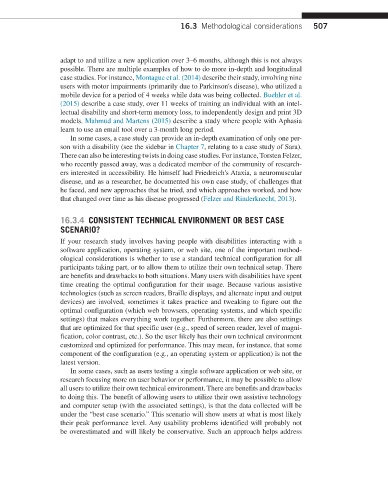Page 514 -
P. 514
16.3 Methodological considerations 507
adapt to and utilize a new application over 3–6 months, although this is not always
possible. There are multiple examples of how to do more in-depth and longitudinal
case studies. For instance, Montague et al. (2014) describe their study, involving nine
users with motor impairments (primarily due to Parkinson's disease), who utilized a
mobile device for a period of 4 weeks while data was being collected. Buehler et al.
(2015) describe a case study, over 11 weeks of training an individual with an intel-
lectual disability and short-term memory loss, to independently design and print 3D
models. Mahmud and Martens (2015) describe a study where people with Aphasia
learn to use an email tool over a 3-month long period.
In some cases, a case study can provide an in-depth examination of only one per-
son with a disability (see the sidebar in Chapter 7, relating to a case study of Sara).
There can also be interesting twists in doing case studies. For instance, Torsten Felzer,
who recently passed away, was a dedicated member of the community of research-
ers interested in accessibility. He himself had Friedreich's Ataxia, a neuromuscular
disease, and as a researcher, he documented his own case study, of challenges that
he faced, and new approaches that he tried, and which approaches worked, and how
that changed over time as his disease progressed (Felzer and Rinderknecht, 2013).
16.3.4 CONSISTENT TECHNICAL ENVIRONMENT OR BEST CASE
SCENARIO?
If your research study involves having people with disabilities interacting with a
software application, operating system, or web site, one of the important method-
ological considerations is whether to use a standard technical configuration for all
participants taking part, or to allow them to utilize their own technical setup. There
are benefits and drawbacks to both situations. Many users with disabilities have spent
time creating the optimal configuration for their usage. Because various assistive
technologies (such as screen readers, Braille displays, and alternate input and output
devices) are involved, sometimes it takes practice and tweaking to figure out the
optimal configuration (which web browsers, operating systems, and which specific
settings) that makes everything work together. Furthermore, there are also settings
that are optimized for that specific user (e.g., speed of screen reader, level of magni-
fication, color contrast, etc.). So the user likely has their own technical environment
customized and optimized for performance. This may mean, for instance, that some
component of the configuration (e.g., an operating system or application) is not the
latest version.
In some cases, such as users testing a single software application or web site, or
research focusing more on user behavior or performance, it may be possible to allow
all users to utilize their own technical environment. There are benefits and drawbacks
to doing this. The benefit of allowing users to utilize their own assistive technology
and computer setup (with the associated settings), is that the data collected will be
under the “best case scenario.” This scenario will show users at what is most likely
their peak performance level. Any usability problems identified will probably not
be overestimated and will likely be conservative. Such an approach helps address

